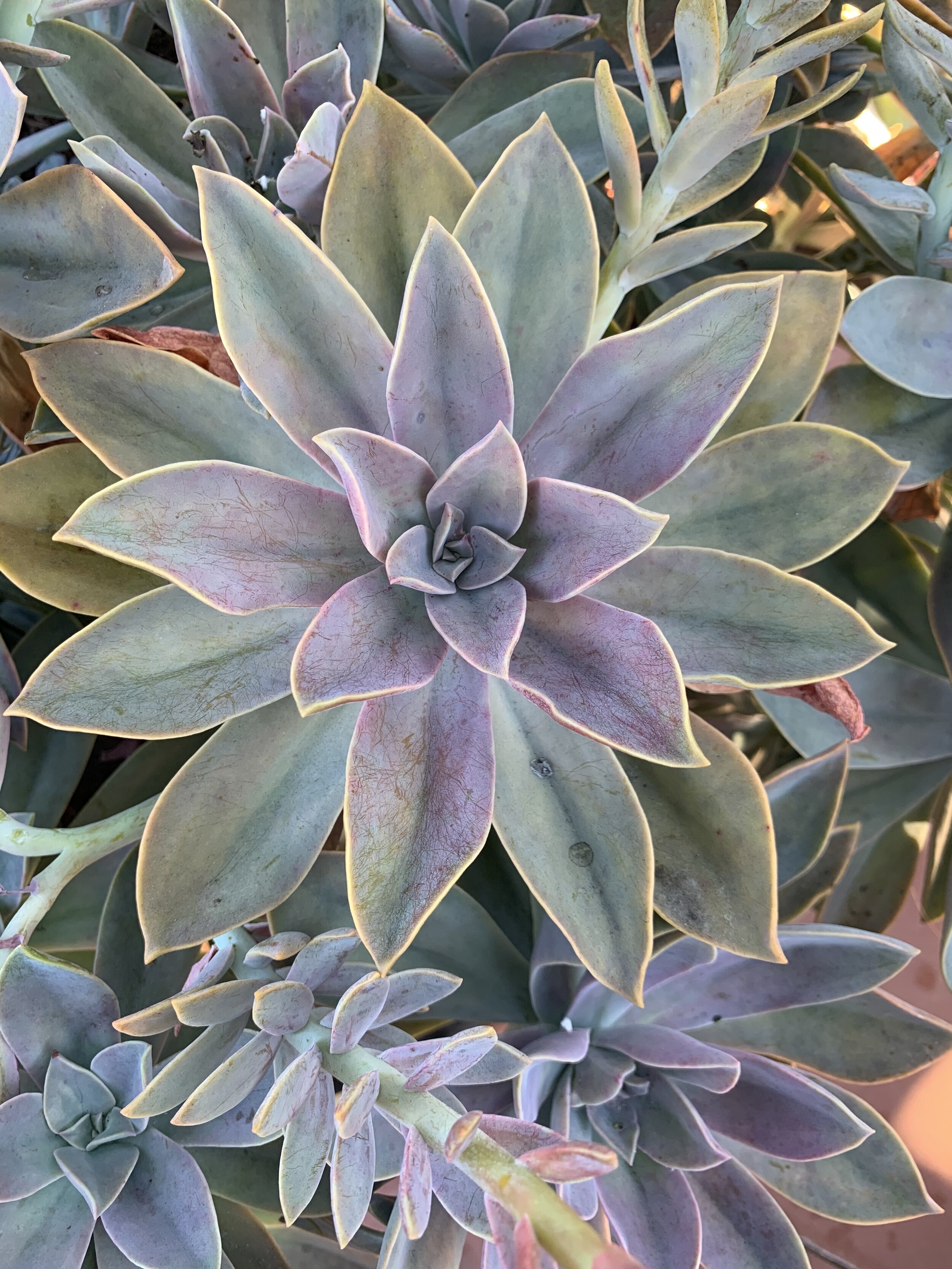Plant of the Month Archive: Graptoveria Fred Ives
a platter filled with clippings of ghost plants and aeonium lilypad
all about “fred ives”
We are well into fall on our way to winter, and as the temperatures dip around us (well maybe not so much here in San Diego, but in lots of other places they are!) I wanted to highlight another one of the superstar succulent color changers – the GRAPTOVERIA FRED IVES! Many succulents are known to react to changes in temperatures through what is referred to as “stress coloring” – as the temperatures and exposure to the sun’s energy changes, so do the pigments of the plants!
First off you might be wondering what is a GRAPTOVERIA, exactly? Graptoveria are a type of succulent that is a hybrid between two other types of succulents Graptopetalum and Echeveria = Graptoveria. Fred Ives was created by combining the ghost plant (graptopetalum paraguayense) and the Echeveria gibbiflora. Succulent growers often cultivate intriguing types of new succulents by hybridizing different types of succulents together. In fact this practice of succulent breeding is the reason why there is such a variety in shapes, colors, textures and sizes of succulents!
Graptoveria Fred Ives is known for its beautiful changing colors of pinks to blue-greens to purples and oranges and yellows too depending on the season. They grow in clumping rosettes that can spread over a foot wide! Fred Ives plants flower mainly through summer (although some of mine are still flowering now in early November here in San Diego) in long arching bloom stalks that can grow up to 2 feet long with dainty yellow flowers with orange & red centers.
caring for your graptoveria fred ives
LIGHT:
These plants prefer bright sunlight to moderate shade. In full sun they will take on more warm hues of maroon, red and orangish-yellow. They don’t like extended cold weather, so if you live in zones that regularly get below 20 degrees Fahrenheit, it’s best to plant these in a pot that can be brought indoors during the colder months. In shade they will maintain more of a green color and will sometimes also stretch out or etoliate.
WATER:
Like with all succulents, best to allow the soil to go completely dry in between watering your ghost plants, especially when planted into pots. This plant will also let you know when it needs to be watered, because it’s thick and fleshy leaves will begin to shrivel. Early signs of overwatering include foliage being easily removed from the plant. For example, brushing against the plant causes a leaf or leaves to fall (HappyDIYHome, 2021).
the bloom of the Graptoveria Fred Ives
PROPAGATION:
The Fred Ives plant is very easy to propagate – as it easily reproduces itself through clippings, dropped leaves and normal pupping. To propagate via clipping, clip the rosette of your choice and remove most of the leaves from the remaining stem (you can hold onto those leaves for propagation as well!). Plant the clipped rosette in well-draining soil, and be sure to wait at least one week before watering to avoid root rot. You can also continue to water the remaining stem and within a few weeks to months, you should see new rosettes begin to grow from the stem.
To propagate via leaves:
Take an intact leaf and lay it upon a small tray of soil or pumice in area with bright indirect sunlight. Do nothing until you begin to see either roots or new baby plant begin to emerge from section of leaf formally attached to the stem. Begin to mist the leaf aiming for the developing roots and plants about 1-2 times per week. Continue to do this for months (and months, it’s a pretty slow and fun process!). When the original leaf is all shriveled up and dry you know it is time to plant your new baby Fred Ives!
Thanks for reading and be sure to reach out with any questions or comments!
With gratitude,
rachael
LOOKING TO ADD MORE SUCCULENTS TO YOUR COLLECTION?
CLICK THE BUTTON BELOW TO SEE THE GORGEOUS SUCCULENT VARIETIES AVAILABLE!


